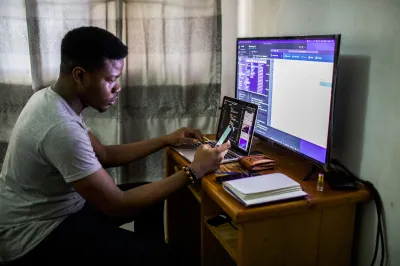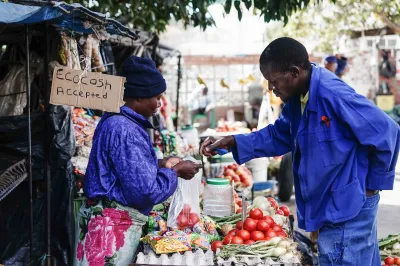Social Performance and Financial Performance: Who’s Pulling Who?
The Microfinance Information Exchange (MIX) has released a new brief, Microfinance Synergies and Trade-Offs: Social versus Financial Performance Outcomes in 2008. The brief uses reported data from 208 MFIs to identify areas in which social performance and financial outcomes may be connected for MFIs. For example, will developing social performance-related incentives for staff raise the cost per borrower for an MFI? (Sadly, their data suggests it does.) Or, is training your staff on social performance connected to better portfolio quality? (In a bit of good news, their data suggest yes, it can.)
In a presentation of this study at CGAP’s offices last week, the author, Adrian González, was hesitant to draw too strong conclusions out of the data collected on social performance by the MIX, as this is the first year they have collected social performance data. However, the fact that they have compiled such an ambitious set of social performance data is a significant victory toward better social reporting. This builds upon years of work by the Social Performance Task Force and other industry leaders in social performance for MFIs, and it will be interesting to see how, in future rounds of data collection, the fine-tuning of the information collected and the growing sample size of MFIs participating will change or confirm some of these initial findings.
One particularly sticky challenge I see going forward is how to determine causality between social and financial performance. For example, consider one of the most basic social performance variables in their data set—targeting of the poor and/or very poor. The data in the MIX study finds that institutions that target the poor have higher operating expenses as a portion of their gross loan portfolio. However, is this because serving the poor is more expensive, or are these MFIs more likely to be nonprofits and NGOs that have placed less emphasis than their for-profit peers on maximizing operating efficiency by cutting down on administrative costs, or extras like educational programs for their clients? Getting a better understanding of the causal relationship between social and financial performance could go a long way towards helping MFI managers find the right synergies that maximize both whenever possible. So be sure to keep your eyes on this interesting work coming out of the MIX, not just because it’s intriguing from a researcher’s perspective, but also for its potential to change the way we view the relationship between social performance and financial viability for an MFI. The more accurate and compelling our data on social performance and financial outcomes, the easier it will be to make a compelling business case to MFIs, which is essential to transform social performance into a priority area across the industry.




Comments
The dilemma in balancing
The dilemma in balancing Social and Financial performance for microfinance is not a unmountable challenge. Balancing needs an unattached motive to assess how financial performance is standardised within the framework of responsiveness. Staff incentive is certainly not the right way. We are witnessing the pressures that staff incentives bring into management time.
Social norms emerge from institutional values – for example, dealing with complaints of clients is a strong mechanism to ensure that MFI remains grounded (only dedicated customers complain !). Turn around time should have slots for open feedback. Every feedback should be open to examining even if the median response is different. In many instances, weak financial performance is result of weak social performance.
1.The real challenge for
1.The real challenge for maximization of social performance (SP)and financial performance (FP) lies in palpable appreciation on the causality between SP and FP. This exercise requires right identification of variables that influence SP being the ultimate purpose under micro finance platform in a given set of target people from poverty sector. Then depending on the nature and extent of interaction among the SP variables in given context, the right synergies for maximization both is possible.
2. Regarding the variables for SP, quantitative targeting of the poor and or /very poor is one dimension for reflecting SP. But this may not be adequate for maximization since the poverty is a multi-faceted phenomenon. Here the fact how well are these target group served with single or double or multiple MF services matching to the needs of the poor in different layers in poverty pyramid. Here, socially embedded multiple financial services include micro savings as social security , micro credit as social lending,, micro insurance as social protection, transfer services as social safety. Further, it may be noted that mere credit service , which most of the MFIs provide, may facilitate the poor in the top layer in the pyramid but it is not sufficient for the given task- poverty reduction in totality. The MFIs (208) who reported to MIX are assumed mostly with credit services only.
3. Further, looking from the demands side, some of the bottom layer poor in general and migratory poor in particular, may need micro saving facility and transfer facility for safe guarding their hard earned money ( not the credit) while many of the vulnerable poor are to be protected with micro insurance services particularly in health arena.. All these variables need to be reckoned in the causality analysis as they all considerably influence social performance.
4. Regarding micro credit product, more trade off for SP could be realized if there are diversified products for meeting the credit needs of different livelihoods and are interlinked with insurance services.( e.g. buffaloes/cows with livestock insurance, bakery with fire insurance etc) In addition to the efforts of MFI in integrating their credit product with non credit products such as training, marketing, go a long way in sustaining the productivity of the micro credit in terms of additional income generation, prompt repayment and enhanced wellness from demand side contributing to SP trade off and eventually at the same time good recovery, assured interest income and profit to the supply side facilitating for FP trade off. Here it may noted that MFI for cost reduction, either individually or jointly coordinate with the respective developing institutions (government & private) like insurance, for providing these integrated multiple services for sustaining the expected trade off between SP and FP .on one hand (as means) and poverty reduction on the other (as the end ). In fact both SP and FP are interlinked and the since former is the foundation for the latter .a better understanding the inherent value chain in the functioning of SP at clients’ level is essential to transform this into priority area across the industry..
5 In fine the MFIs who are mostly erstwhile NGOs with the expertise in social work, they could very well individually (like BRAC) or join hands with like minded development partners including government who provide non credit extension support and of late micro insurance with free premium to the poor, marketing facility for SHG products, training etc., as in India ) in arranging multiple services matching to the needs of the poor clients. Socially oriented project demands dynamism on the part of human resources for effective synthesis , ethical ways in their approach and quality in products and services for ensuring a sustainable trade off for both SP and FP in a balanced manner.
V.Rengarajan
Add new comment